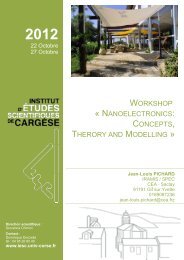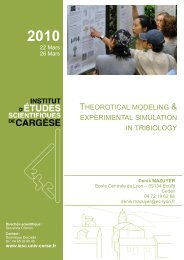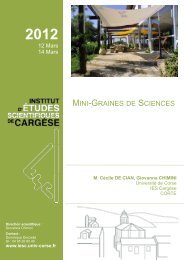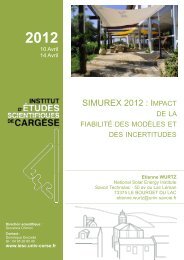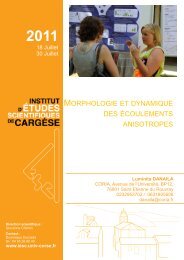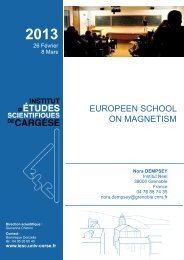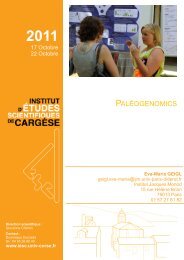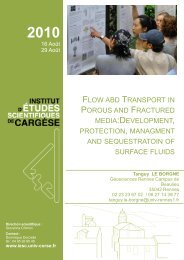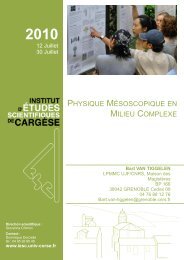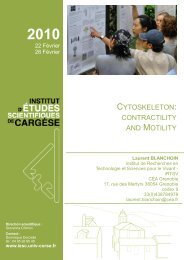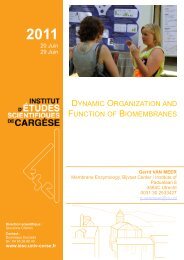Mathias FINK - Institut d'études scientifiques de Cargèse (IESC)
Mathias FINK - Institut d'études scientifiques de Cargèse (IESC)
Mathias FINK - Institut d'études scientifiques de Cargèse (IESC)
Create successful ePaper yourself
Turn your PDF publications into a flip-book with our unique Google optimized e-Paper software.
2013<br />
27 Mai<br />
31 Mai<br />
CONTROLLING WAVE<br />
PROPAGATION IN COMPLEX<br />
MEDIA : FROM SHAPING<br />
WAVE FIELDS TO DESIGNING<br />
SMART MATERIALS<br />
<strong>Mathias</strong> <strong>FINK</strong><br />
LOA - ESPCI<br />
Paris<br />
France<br />
<strong>Mathias</strong>.fink@espci.fr<br />
Direction scientifique :<br />
Giovanna Chimini<br />
Contact :<br />
Dominique Donzella<br />
tél : 04 95 26 80 40<br />
www.iesc.univ-corse.fr
CONTROLLING THE PROPAGATION OF WAVES<br />
IN COMPLEX MEDIA: FROM SHAPING WAVE<br />
FIELDS TO DESIGNING SMART MATERIALS<br />
May 27th - June 1st, 2013<br />
<strong>Institut</strong> Scientifique <strong>de</strong> <strong>Cargèse</strong>, Corsica, France<br />
Director: <strong>Mathias</strong> Fink
Speakers<br />
• Hui Cao - Yale University - USA<br />
• <strong>Mathias</strong> Fink - <strong>Institut</strong> Langevin, ESPCI ParisTech - France<br />
• Ad Lagendijk - University of Amsterdam - Netherlands<br />
• Georg Maret - University of Konstanz - Germany<br />
• David A.B. Miller - Stanford University - USA<br />
• John Page - University of Manitoba - Canada<br />
• Morchedaï Segev - Technion - Israel<br />
• Lihong Wang - Washington University in St. Louis - USA<br />
• Martin Wegener - Karlsruhe <strong>Institut</strong>e of Technology - Germany<br />
• Nikolaï Zhelu<strong>de</strong>v - University of Southampton - UK<br />
• Clau<strong>de</strong> Boccara - <strong>Institut</strong> Langevin, ESPCI ParisTech - France<br />
• Rémi Carminati - <strong>Institut</strong> Langevin, ESPCI ParisTech - France<br />
• Didier Felbacq- Université Montpellier 2 - France<br />
• Sylvain Gigan - <strong>Institut</strong> Langevin, ESPCI ParisTech - France<br />
• Stefan Enoch - <strong>Institut</strong> Fresnel, CNRS - France<br />
• Vincent Lau<strong>de</strong> - Femto-ST institute, CNRS - France<br />
• Allard Mosk - University of Twente - Netherlands<br />
• José Sanchez-Dehesa - Universitat Politècnica <strong>de</strong> València - Spain<br />
• Sergey Skipetrov - Université Grenoble I, CNRS - France<br />
Scientific Committee<br />
Pr. Clau<strong>de</strong> Boccara, Pr. Hui Cao, Pr. <strong>Mathias</strong> Fink (director), Pr. Ad Lagendijk<br />
Organizing Committee<br />
Julien <strong>de</strong> Rosny, Geoffroy Lerosey, Alexandre Aubry, Lorraine Monod<br />
<strong>Institut</strong> Langevin, Paris, France
Schedule<br />
Time\Day Monday Tuesday Wednesday Thurday Friday<br />
9h-10h30 <strong>Mathias</strong> Fink John Page Georg Maret Ad Lagendijk Nick Zhelu<strong>de</strong>v<br />
11h-12h30 David Miller<br />
Martin<br />
Wegener<br />
Hui Cao Lihong Wang Moti Segev<br />
12h30-16h30<br />
16h30-17h30<br />
Lunch +<br />
Discussions +<br />
Beach<br />
Allard Mosk<br />
Lunch +<br />
Discussions +<br />
Beach<br />
Rémi<br />
Carminati<br />
17h30-18h30 Didier Felbacq Vincent Lau<strong>de</strong><br />
Welcome<br />
drink<br />
(6:30 pm)<br />
Lunch +<br />
Poster<br />
Session<br />
(13h30-17h)<br />
José<br />
Sanchez-<br />
Dehesa<br />
(17h-18h30)<br />
Lunch +<br />
Discussions +<br />
Beach<br />
Sergey<br />
Skipetrov<br />
Clau<strong>de</strong><br />
Boccara<br />
Diner<br />
(7:30pm)<br />
Lunch<br />
Stefan Enoch<br />
(13h30-14h30)<br />
Sylvain Gigan<br />
(14h30-15h30)<br />
THE END<br />
The abstracts of the lectures are available at http://www.institutlangevin.espci.fr/Program,609<br />
Lecture titles<br />
Pr. Hui Cao<br />
Pr. <strong>Mathias</strong> Fink<br />
Pr. Ad Lagendijk<br />
Pr. Georg Maret<br />
Pr. David A.B. Miller<br />
Pr. John Page<br />
Pr. Morchedaï Segev<br />
Pr. Lihong Wang<br />
Pr. Martin Wegener<br />
Pr. Nikolay Zhelu<strong>de</strong>v<br />
Pr. Clau<strong>de</strong> Boccara<br />
Pr. Rémi Carminati<br />
Pr. Didier Felbacq<br />
Dr. Sylvain Gigan<br />
Dr. Stefan Enoch<br />
Pr. Vincent Lau<strong>de</strong><br />
Pr. Allard Mosk<br />
Pr. José Sánchez-Dehesa<br />
Dr. Sergey Skipetrov<br />
Light transport through random media: Physics and application<br />
Transition to An<strong>de</strong>rson localization of light in three dimensions<br />
How to <strong>de</strong>sign any linear optical component and how to avoid it?<br />
An<strong>de</strong>rson Localization of Ultrasound in Three-Dimensional Mesoglasses<br />
An<strong>de</strong>rson Localization of Light and Beyond<br />
Synergy between light and sound : photoacoustic tomography and TRUE<br />
optical focusing<br />
Transformation materials for optics, elastodynamics, and thermodynamics<br />
What’s matter with meta matter?<br />
Random behavior in optical coherence<br />
Weak and strong coupling regimes of light-matter interaction in nanoscale<br />
Universality and scaling in topological metamaterials<br />
Matricial approach to optical wavefront engineering<br />
Scaling up the holes : Towards Seismic metamaterials<br />
Phononic crystals for the control of acoustic waves<br />
Recent advances on acoustic metamaterials<br />
Quantum optical resources for imaging and wave control in random media
Pr. Hui Cao<br />
Light transport through random media : physics and application<br />
The first part is the fundamental study of light transport through disor<strong>de</strong>red photonic wavegui<strong>de</strong>s.<br />
We have observed position-<strong>de</strong>pen<strong>de</strong>nt diffusion by probing light propagating insi<strong>de</strong> a quasi-twodimensional<br />
random system from the third dimension. The system size and shape are <strong>de</strong>signed to<br />
enhance the interference of scattered waves so that the diffusion coefficient is modified appreciably.<br />
We also use dissipation to control the effective system size, and tune the value of diffusion<br />
coefficient via the interplay of localization and dissipation. This work <strong>de</strong>monstrates the possibility<br />
of utilizing the geometry of a random system or the dissipation to manipulate wave diffusion.<br />
The second part is the application of random media to spectrograph. We have <strong>de</strong>signed and<br />
fabricated an on-chip spectrometer based on random arrays of scatterers. The speckle patterns are<br />
recor<strong>de</strong>d and used to reconstruct the input spectra after the spectral-spatial mapping is calibrated.<br />
Multiple scattering of light increases the effective optical path length, facilitating the spectral<br />
<strong>de</strong>correlation of speckle. It allows us to dramatically reduce the <strong>de</strong>vice size without sacrificing<br />
spectral resolution. To reduce the insertion loss, we incorporate certain <strong>de</strong>gree of or<strong>de</strong>r to the<br />
random spectrometer. We have also used the speckle generated by a multimo<strong>de</strong> optical fiber to<br />
recover the input spectra. This fiber spectrometer gives high-resolution and has low-loss. A<br />
wavelength resolution of 8 pm is achieved with a 20 meter long fiber and a broadband operation<br />
covering the visible spectrum is obtained with 1.5 nm resolution using a 2cm long fiber.<br />
Pr. Georg Maret<br />
Transition to An<strong>de</strong>rson localization of light in three dimensions<br />
Georg Maret, Wolfgang Bührer, Tilo Sperling and Christof Aegerter<br />
We report experiments on the time resolved transmission of multiple scattered light in strongly<br />
turbid three dimensional media composed of high in<strong>de</strong>x (titania) nanoparticles. At small values of<br />
kl*, with wave vector k and transport mean free path l*, and at long times the total transmission is<br />
<strong>de</strong>layed [1] and the width of the intensity profile at the backsi<strong>de</strong> of the sample saturates [2]. These<br />
<strong>de</strong>viations from diffusive transport which cannot be accounted for by absorption indicate a<br />
transition to 3D An<strong>de</strong>rson localization. Data for samples with different thickness and turbidity<br />
provi<strong>de</strong> a direct <strong>de</strong>termination of their localization length as function of kl* and allow to <strong>de</strong>termine<br />
the critical value kl*c of the transition. We also discuss the spectral and power <strong>de</strong>pen<strong>de</strong>nce of the<br />
transmission which reveal the presence of nonlinear effects [3].<br />
[1] M. Störzer, P. Gross, C.M. Aegerter and G. Maret, Phys.Rev.Lett. 96, 063904 (2006).<br />
[2] T. Sperling, W. Bührer, C.M. Aegerter and G. Maret, Nature Photonics, 7, 48-52 (2013)<br />
[3] W. Bührer et.al. to be published<br />
Pr. David A.B. Miller<br />
How to <strong>de</strong>sign any linear optical component and how to avoid it ?<br />
Any linear optical structure or <strong>de</strong>vice can be readily un<strong>de</strong>rstood mathematically, but we have not<br />
known historically how to <strong>de</strong>sign any such <strong>de</strong>vice. For example, current challenging practical<br />
<strong>de</strong>vices inclu<strong>de</strong> efficient arbitrary spatial mo<strong>de</strong> splitters and converters for multimo<strong>de</strong> fiber and<br />
advanced free-space communications, especially avoiding any avoid fundamental power splitting<br />
loss. Here we show the first complete constructive method for <strong>de</strong>sign of an arbitrary linear optical<br />
<strong>de</strong>vice. In the spirit of a universal machine, this proves any linear optical <strong>de</strong>vice is possible in<br />
principle. We propose practical approaches for spatial <strong>de</strong>vices. Finally, we show how all such<br />
actual <strong>de</strong>sign work can be avoi<strong>de</strong>d completely in systems that can configure themselves without
performing any calculations.<br />
Pr. John H. Page<br />
An<strong>de</strong>rson Localization of Ultrasound in Three-Dimensional Mesoglasses<br />
The question of whether or not the An<strong>de</strong>rson localization of classical waves can really occur in<br />
three-dimensional disor<strong>de</strong>red materials has intrigued physicists for many years. Recently there has<br />
been consi<strong>de</strong>rable progress in answering this question, with the most direct <strong>de</strong>monstration of 3D<br />
An<strong>de</strong>rson localization being first established in acoustics, through measurements of the dynamic<br />
transverse confinement of energy in a “mesoglass” consisting of a disor<strong>de</strong>red elastic network of<br />
aluminum beads [1]. In this approach, an inci<strong>de</strong>nt ultrasonic point source is used, and the spatial<br />
extent of the transmitted intensity is measured as a function of time on the opposite si<strong>de</strong> of the<br />
sample. For diffuse waves, the spatial intensity profile on the sample surface is Gaussian, and the<br />
width squared grows linearly with time. For localized waves, the transverse spreading of the<br />
intensity is cut off, and the width saturates at long propagation times, giving information on the<br />
localization length. Thus, measurements of this dynamic transverse width provi<strong>de</strong> a very direct way,<br />
which is in<strong>de</strong>pen<strong>de</strong>nt of absorption, of distinguishing between diffusive and localized states [1].<br />
After reviewing our initial experiments and their successful interpretation using the self-consistent<br />
theory of localization [2], I will show how the transverse width evolves with time as frequency is<br />
varied, and a mobility edge, separating exten<strong>de</strong>d from localized waves, is crossed. This work is<br />
enabling us to study aspects of classical wave localization near the An<strong>de</strong>rson transition that have<br />
not been amenable to experimental investigation previously, such as the multifractal spatial<br />
structure of localized wavefunctions [3], long-range and even infinite-range correlations of the<br />
intensity with position and frequency [4], and dynamic backscattering phenomena that reveal, in<br />
addition to the effects of localization on time-<strong>de</strong>pen<strong>de</strong>nt coherent backscattering, a surprisingly<br />
large recurrent scattering contribution.<br />
[1] H. Hu, A. Strybulevych, J.H. Page, S.E. Skipetrov and B.A. van Tiggelen, Nature Phys. 4, 945-8<br />
(2008).<br />
[2] N. Cherroret, S.E Skipetrov, and B.A van Tiggelen, Phys. Rev. E 82, 056603 (2010).<br />
[3] S. Faez, Anatoliy Strybulevych, J.H. Page, A. Lagendijk and B.A. van Tiggelen, Phys. Rev. Lett.<br />
103, 155703 (2009).<br />
[4] W.K. Hil<strong>de</strong>brand, A. Strybulevych, S.E. Skipetrov, B.A. van Tiggelen, and J.H. Page,<br />
arXiv:1303.7042.<br />
Pr. Morchedaï Segev<br />
An<strong>de</strong>rson Localization of Light and Beyond<br />
An<strong>de</strong>rson Localization is one of the most basic concepts in solid-state physics. However,<br />
experiments with electronic systems have elu<strong>de</strong>d scientists for many <strong>de</strong>ca<strong>de</strong>s. Three <strong>de</strong>ca<strong>de</strong>s after<br />
An<strong>de</strong>rson’s prediction, the concept has been exten<strong>de</strong>d to optics, and in 2007, our group has ma<strong>de</strong><br />
the first <strong>de</strong>monstration of An<strong>de</strong>rson localization in its original context, where random fluctuations<br />
superimposed upon a periodic structure bring transport to a halt. Many experimental works have<br />
followed, in optics and matter-waves. But can disor<strong>de</strong>r work to increase transport beyond diffusion,<br />
and perhaps even beyond ballistic transport ? The talk will review the recent progress on An<strong>de</strong>rson<br />
localization of light, and will <strong>de</strong>scribe experiments and theory <strong>de</strong>monstrating disor<strong>de</strong>red–enhanced<br />
transport in photonic quasicrystals, and hyper-transport of light in photonic media with evolving<br />
disor<strong>de</strong>r : a new regime of transport in which an arbitrary wavepacket expands at a rate faster than<br />
ballistic.<br />
Pr. Lihong Wang<br />
Synergy between light and sound : photoacoustic tomography and TRUE optical focusing
Photoacoustic tomography (PAT), combining optical and ultrasonic waves via the photoacoustic<br />
effect, provi<strong>de</strong>s in vivo multiscale non-ionizing functional and molecular imaging. PAT is the only<br />
modality capable of imaging across the length scales of organelles, cells, tissues, and organs with<br />
consistent contrast. PAT has the potential to empower multiscale systems biology and accelerate<br />
translation from microscopic laboratory discoveries to macroscopic clinical practice. PAT may also<br />
hold the key to the earliest <strong>de</strong>tection of cancer by in vivo label-free quantification of<br />
hypermetabolism, the quintessential hallmark of cancer. Time-reversed ultrasonically enco<strong>de</strong>d<br />
(TRUE) optical focusing is based on ultrasonic modulation of coherence light propagating in<br />
scattering tissue followed by time reversal of the ultrasonically enco<strong>de</strong>d light component. TRUE<br />
focusing can noninvasively <strong>de</strong>liver light to a dynamically <strong>de</strong>fined focus <strong>de</strong>ep in a scattering<br />
medium. This technology opens the door to an even greater paradigm-shifting opportunity—one<br />
that controls the photon paths to minimize transmission loss in tissue.<br />
Pr. Martin Wegener<br />
Transformation materials for optics, elastodynamics, and thermodynamics<br />
I review our experimental efforts regarding implementing the i<strong>de</strong>as of transformation optics in the<br />
areas of optics, mechanics, and thermodynamics. This requires <strong>de</strong>signing and fabricating artificial<br />
materials with intentionally spatially inhomogeneous and/or anisotropic effective material<br />
properties. In optics, visible-frequency broadband polarization-in<strong>de</strong>pen<strong>de</strong>nt three-dimensional<br />
carpet cloaks have become possible. In mechanics, broadband two-dimensional free-space cloaks<br />
have been <strong>de</strong>monstrated and pentamo<strong>de</strong> metamaterials for three-dimensional architectures are<br />
emerging. In thermodynamics, two-dimensional free-space cloaks have recently become possible -<br />
bringing us back to the beginnings of the field, i.e., to the Cal<strong>de</strong>ron tomography problem.<br />
Pr. Nikolay Zhelu<strong>de</strong>v<br />
What’s matter with meta matter ?<br />
We report on recent <strong>de</strong>velopments in metamaterials and nanophotonics research. Out particular<br />
focus will be on coherent control of signals with metamaterials, generation of vector potential fields<br />
with toroidal structures and using photonic network as oracle for solving complex <strong>de</strong>cision<br />
problems.<br />
Pr. Clau<strong>de</strong> Boccara<br />
Random behavior in optical coherence<br />
The randomness of the refractive in<strong>de</strong>x and/or the position of the scatterers blur the images in<br />
biological tissues. OCT by selecting singly backscattered photons is a first approach that allows<br />
overcoming this problem. Even with incoherent sources the OCT signal exhibits a speckle<br />
distribution. Despite of the speckle in the images the Full Field OCT (FFOCT) approach that we<br />
have <strong>de</strong>veloped allows to reveal the tissue morphology at the micron scale and starts to be a<br />
valuable tool in intra operative surgery. Sometimes the morphology is not enough to characterize<br />
the tissue, so we will examine the basic nature of the signal and what kind of supplementary<br />
information can be extracted from the OCT data such as local refractive in<strong>de</strong>x, <strong>de</strong>nsity of scatterers<br />
and elasticity map. Finally (because we are in Cargese !) I will shows how FFOCT is used to count<br />
and characterize, through their Brownian trajectories, viruses in see water.<br />
Pr. Rémi Carminati<br />
Weak and strong coupling regimes of light-matter interaction in nanoscale disor<strong>de</strong>red media<br />
The interplay between multiple scattering, near-field interactions and material resonances in
disor<strong>de</strong>red media leads to substantial changes in the photonic properties, compare to that of bulk<br />
materials. Changes in the local <strong>de</strong>nsity of optical states (LDOS) influence spontaneous emission as<br />
well as absorption of light (weak coupling regime or Purcell effect). Disor<strong>de</strong>r also influences the<br />
intrinsic spatial coherence that can be <strong>de</strong>scribed by the concept of cross <strong>de</strong>nsity of states (CDOS). A<br />
reduction of the intrinsic spatial coherence can reveal the spatial localization of mo<strong>de</strong>s in a<br />
complex system. The strong coupling regime can even be reached between a resonant scatterer (or<br />
emitter) and an An<strong>de</strong>rson localized mo<strong>de</strong>. In the lecture we will focus on the basic concepts used to<br />
<strong>de</strong>scribe the different interaction regimes, and illustrate the main trends based on numerical<br />
simulations and experiments. We will also discuss some analogies between different kind of<br />
measurements that are actually driven by the same features of the un<strong>de</strong>rlying structure of the optical<br />
eigenmo<strong>de</strong>s.<br />
Pr. Didier Felbacq<br />
Universality and scaling in topological metamaterials<br />
The presentation will <strong>de</strong>al with electromagnetic wave propagation in a mo<strong>de</strong>l metamaterial ma<strong>de</strong> of<br />
dielectric rods. The scatterers are such that they present a double resonance (magnetic and electric)<br />
in such a way that conduction bands are opened. A low frequency analysis will show that the<br />
behavior of the system can be <strong>de</strong>scribed by resonant (dispersive) electromagnetic parameters ε and<br />
μ. The bands have universal features with respect to symmetry and scaling, that will be explored<br />
numerically. The link with photonic topological insulators will be discussed as well as the transition<br />
to An<strong>de</strong>rson localization.<br />
Dr. Sylvain Gigan<br />
Matricial approach to optical wavefront engineering<br />
The randomness of the refractive in<strong>de</strong>x and/or the position of the scatterers blur the images in<br />
biological tissues. OCT by selecting singly backscattered photons is a first approach that allows<br />
overcoming this problem. Even with incoherent sources the OCT signal exhibits a speckle<br />
distribution. Despite of the speckle in the images the Full Field OCT (FFOCT) approach that we<br />
have <strong>de</strong>veloped allows to reveal the tissue morphology at the micron scale and starts to be a<br />
valuable tool in intra operative surgery. Sometimes the morphology is not enough to characterize<br />
the tissue, so we will examine the basic nature of the signal and what kind of supplementary<br />
information can be extracted from the OCT data such as local refractive in<strong>de</strong>x, <strong>de</strong>nsity of scatterers<br />
and elasticity map. Finally (because we are in Cargese !) I will shows how FFOCT is used to count<br />
and characterize, through their Brownian trajectories, viruses in see water.<br />
Dr. Stefan Enoch<br />
Scaling up the holes : Towards Seismic metamaterials<br />
It has been recently suggested that structured media can bend light trajectories the wrong way,<br />
making a flat convergent superlens, or even <strong>de</strong>tour light around an objsect, making an invisibility<br />
cloak. Such electromagnetic metamaterials introduced by Sir John Pendry during the last <strong>de</strong>ca<strong>de</strong><br />
have counterparts in acoustics. In this talk, I will focus my attention on certain type of surface<br />
waves : flexural (Lamb) waves propagating within thin elastic metamaterial plates which have been<br />
experimentally studied this year by research groups in Wegener in Karlsruhe, Van<strong>de</strong>nberghe in<br />
Marseille, with applications thought in cloaking, and Sebbah’s group in Paris, where the dynamics<br />
of a flat lens for Lamb waves has been unveiled. Interestingly, control of flexural waves opens a<br />
route towards seismic metamaterials. First experiments performed by multinational company<br />
Menard this year near the French cities of Grenoble and Lyon <strong>de</strong>monstrate that one can shield or<br />
even focus a seismic wave of magnitu<strong>de</strong> 4 on the Richter scale through an array of meter sized
holes drilled in a rather homogeneous soil.<br />
Pr. Vincent Lau<strong>de</strong><br />
Phononic crystals for the control of acoustic waves<br />
Phononics can be <strong>de</strong>fined as the science of <strong>de</strong>signing artificial acoustic materials with tailored<br />
dispersion properties. Of special interest are phononic crystals, two- or three-dimensional<br />
periodically structured materials that show a number of amazing properties - but only if properly<br />
<strong>de</strong>signed. For instance, strong confinement of wave energy can be obtained insi<strong>de</strong> complete band<br />
gaps, i.e., frequency ranges within which no wave propagation is allowed, whatever the inci<strong>de</strong>nce<br />
and the polarization. Even outsi<strong>de</strong> band gaps, the periodic structure leads to very strong spatial<br />
dispersion, resulting in properties unavailable with usual homogeneous materials. I will highlight<br />
recent achievements in the field of phononics and use them to emphasize that much remains to be<br />
achieved. Topics inclu<strong>de</strong> experimental <strong>de</strong>monstrations of band gaps, waveguiding and cavity<br />
<strong>de</strong>sign, crystals for surface acoustic waves, and phononic crystal slabs.<br />
Pr. José Sánchez-Dehesa<br />
Recent Advances on Acoustic Metamaterials<br />
I will start reporting the advances on acoustic cloaking and our experimental <strong>de</strong>monstration of 2D<br />
and 3D acoustic cloaks based on scattering cancellation. Afterwards, I will review the latest results<br />
on acoustic metamaterial with negative parameters and <strong>de</strong>nsity near zero materials. In these topics,<br />
the multiple scattering method has been employed as a tool to <strong>de</strong>sign building units of artificial<br />
structures whose effective parameters can be adjusted. Experiments supporting the theoretical<br />
prediction will be also <strong>de</strong>scribed.<br />
Dr. Sergey Skipetrov<br />
Quantum optical resources for imaging and wave control in random media<br />
Many imaging and adaptive techniques can be realized in very similar ways with different kinds of<br />
waves : light, microwaves, sound or elastic waves, for example. Light has, however, an important<br />
difference as compared to other waves : it exhibits manifest and readily controllable quantum<br />
properties un<strong>de</strong>r standard experimental conditions (room temperature, atmospheric pressure,<br />
visible wavelength). The purpose of this lecture will be to imagine and explore the possible uses of<br />
this new, quantum resource for practical purposes. In particular, we will discuss the use of nonclassical<br />
states of light (Fock and squeezed states) to probe turbid media, as well as the potential of<br />
quantum entanglement between photons to control their propagation through a random<br />
environment.



